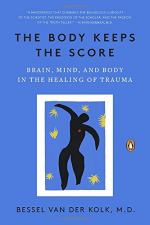|
This section contains 691 words (approx. 2 pages at 400 words per page) |

|
The Body Keeps the Score: Brain, Mind, and Body in the Healing of Trauma Summary & Study Guide Description
The Body Keeps the Score: Brain, Mind, and Body in the Healing of Trauma Summary & Study Guide includes comprehensive information and analysis to help you understand the book. This study guide contains the following sections:
This detailed literature summary also contains Topics for Discussion on The Body Keeps the Score: Brain, Mind, and Body in the Healing of Trauma by Bessel van der Kolk M.D..
The following version of this book was used to create this study guide: van der Kolk, Bessel. The Body Keeps the Score. Penguin Books, an imprint of Penguin Random House LLC. New York, NY. 2015. First Paperback Edition.
While the book’s overall perspective is defined by aspects of science, the author also integrates elements of memoir, anecdote, and case studies to put a human face on his subject. The book’s explorations begin with a Prologue, in which author van der Kolk introduces the idea that experiences of trauma are both widespread and multifaceted. In particular, he references how trauma’s effects move out beyond individual experience and into the larger sphere of community, both personal and societal. He concludes the Prologue by offering personal insight into why the issues of trauma and recovery are important enough for him to have put his book together.
What follows – that is, the main body of the book – is broken down into five parts. The first four are relatively short; the fifth is substantially longer. Part One focuses on the recent history of research into trauma – that is, research into both its effects and methods of recovery. In doing so, Part One traces the history of diagnosis and analysis of trauma’s various component experiences, focusing on how human brains that have been affected by trauma function on a physiological level. Part Two continues this avenue of exploration, but shifts focus onto analysis of the physiological function of the mind – that is, how the brain perceives and reacts to stimuli, traumatic or otherwise. Chapter Four in this section goes into particular, expansive detail on this aspect of the book’s main topic.
In Part Three, the focus of both the author and the book shift from a general focus on the experiences of traumatized adults and onto a more specific focus on the experiences of traumatized children. He examines the history and importance of this aspect of the research, cataloguing ways in which childhood trauma can, and almost inevitably does, affect behavior when those who have experienced trauma at a young age reach adolescence and adulthood. He considers how trauma transforms the world views of children; considers difficulties associated with both diagnosis and treatment of young people; and suggests that childhood abuse of any sort (physical, sexual, emotional) is becoming a culturally significant epidemic among young people, specifically in the United States.
As it moves into Part Four, the narrative shifts focus again – this time, onto the complex relationship between trauma and memory. Here the author focuses on the different ways that memory is manipulated and shaped by trauma sufferers in an effort to reduce trauma’s effects. He also comments extensively on how one of the goals of any sort of therapeutic treatment of trauma is to consider and implement ways in which memories can be successfully integrated into day-to-day life without causing that life to become disrupted.
Part Five then shifts focus again, moving from consideration of the effects of trauma onto different ways that trauma can be healed. Here, the author picks up a theme that he has been developing throughout the book: that is, his repeated suggestion that traditional therapies, often associated with medications, do not do what is needed to do to engage and sustain recovery. Then, chapter by chapter, takes that argument in a variety of different directions as he considers alternative therapies ranging from yoga to acting. All these therapies, he suggests, demonstrate the various ways that trauma sufferers can healthily and safely reconnect with their bodies, their identities, and the people in their lives.
Finally, the book concludes with a lengthy, impassioned Epilogue in which the author concentrates on again making the case for expanded, deepened consideration of trauma’s effects on children, and for broad-based, well-funded research into alternative therapies. He concludes by reiterating his earlier claim that society as a whole could, and would, benefit from a substantial rethinking about approaches and reactions to trauma. He suggests that experiencing, dealing with, and recovering from trauma has become the most urgent public health issue in the United States, and arguably in the world.
Read more from the Study Guide
|
This section contains 691 words (approx. 2 pages at 400 words per page) |

|



